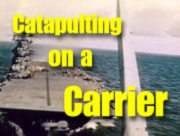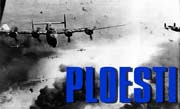Zeno's Warbird Video Drive-In August Newsletter: Four Cool Films for the Dog Days of August now showing at Zeno's Warbird Video Drive-In
You are invited to drop by Zeno's Drive-In (www.zenoswarbirdvideos.com) and catch our latest World War II aviation features for free online video viewing. This month "At the Matinee," we're showing the return of two Drive-In favorites,"Raids on Ploesti" & "Collecting and Reporting Enemy Information for Fighter Pilots," and the debut of an exciting new feature, "Catapulting on a Carrier." All for free online streaming video viewing And there's a new addition to our "More Neat Stuff" section: excerpts from a real Douglas A-26 Invader attack bomber pilot's manual. (The downloads we added recently for Spitfire II and Me-262 pilot's manuals are extremely popular. Look for a download of a De Havilland Mosquito manual next month.)

* Catapulting on a Carrier World War II aircraft carriers depended on their catapults. This unique film offers a rare look (in color) at how US Navy carrier crews were trained to operate a steam catapults to launch aircraft, even from very short decks. As a bonus, you'll see GM FM-1 "Wildcats" up close, handled expertly on the tiny deck of a CVE "jeep" escort carrier. Built on merchant men hulls, the 78 jeeps were pressed into service for a variety of rolls, including anti submarine war in the Atlantic and covering amphibious landings in the Pacific, Their greatest moment came on Oct. 35, 1944, in the battle of Samar in the Philippines, when the CVEs of Task Group 77.4 (Task units "Taffy 1, 2, 4") launched a furious attack on Adm. Kurita's overwhelming task force and caused it to retreat. The CVE St Lo was lost and several others were heavily damaged, but the landing at Leyte was successfully protected.

Raids on Ploesti Double Feature -- August 1 marks the 62nd anniversary of the epic low level
B-24 raid on the Romanian oil fields
* Medal of Honor: Ploesti. On August 1, 1943 specially trained elements of the 8th and 9th Air Forces flying B-24 Liberators based in Benghazi Libya launched a daring low level attack on Ploesti, over 1,200 miles away. They struck hard, but the cost was high. Unescorted by fighters and coming in literally at tree top level to surprise the enemy, 54 out of 162 of the attacking bombers were lost, along with 540 American air crew. Every member of the attacking force was awarded a medal, including 5 Medals of Honor, the highest decoration awarded by the U.S. military. Of the Medal of Honor recipients, only Col. Leon Johnson, 44th Bomb Group, and Col. Jon "Killer" Kane, 98th Bomb Group, survived the mission.
* Air Siege Ploesti March to August 1944 The capture of the Foggia airfield in on the Adriatic in Italy in 1944 provided the 15th Air Force with a new base to launch a new series of Air attacks on Ploesti. This time, B-17s and B-24s attacked with fighter escort at high altitude. Losses were again heavy, with over 1,800 air crew lost to FLAK and enemy fighters. Accuracy suffered when defenders used smoke pots to obscure the target, so P-38s were used as dive bombers to penetrate the defenses. Soon P-51s helped to achieve total air superiority over the target. By the end of the Ploesti air campaign in the fall of 1944, 90% of Romania's oil production was knocked out, at a cost of 270 bombers and 49 fighters and their crews. Narrated by Ronald Reagan.
* Collecting and Reporting Enemy Information by Fighter Pilots" is a rare early war training film featuring Bell P-39 Airacobras of the "181st Squadron" carrying out a complete bomber escort and ground attack mission, with an emphasis on briefing sessions, gathering intelligence during a combat mission, and how to give accurate after action reports. Basic squadron tactics of the strike are also covered. Some excellent & rare P-39 footage.
If you haven't stopped by Zeno's Drive-In before, we also feature 1940-45 vintage WWII Army & Navy films on how to fly the F4U, F6F, P-38, P-39, P-40, P-47, P-51, P-61, TBF/TBM, AT-6/SNJ, B-17, B-24, B-25, A-20, A-26, B-26, B-29, Stearman N2S and a different WWII documentaries every month "At the Matinee." That's over 14 hours of rockin' props for free viewing over the internet,
Finally, we've revised, expanded, and updated our "Control Tower" links page, which has the largest collection of World War II Aviation links on the 'net So drop your flaps & drop in! That's http://www.zenoswarbirdvideos.com
Zeno
Vids:WW2 Carrier Catapults, Ploesti Raids Now Showing @ Zeno's
You are invited to drop by Zeno's Drive-In (www.zenoswarbirdvideos.com) and catch our latest World War II aviation features for free online video viewing. This month "At the Matinee," we're showing the return of two Drive-In favorites,"Raids on Ploesti" & "Collecting and Reporting Enemy Information for Fighter Pilots," and the debut of an exciting new feature, "Catapulting on a Carrier." All for free online streaming video viewing And there's a new addition to our "More Neat Stuff" section: excerpts from a real Douglas A-26 Invader attack bomber pilot's manual. (The downloads we added recently for Spitfire II and Me-262 pilot's manuals are extremely popular. Look for a download of a De Havilland Mosquito manual next month.)

* Catapulting on a Carrier World War II aircraft carriers depended on their catapults. This unique film offers a rare look (in color) at how US Navy carrier crews were trained to operate a steam catapults to launch aircraft, even from very short decks. As a bonus, you'll see GM FM-1 "Wildcats" up close, handled expertly on the tiny deck of a CVE "jeep" escort carrier. Built on merchant men hulls, the 78 jeeps were pressed into service for a variety of rolls, including anti submarine war in the Atlantic and covering amphibious landings in the Pacific, Their greatest moment came on Oct. 35, 1944, in the battle of Samar in the Philippines, when the CVEs of Task Group 77.4 (Task units "Taffy 1, 2, 4") launched a furious attack on Adm. Kurita's overwhelming task force and caused it to retreat. The CVE St Lo was lost and several others were heavily damaged, but the landing at Leyte was successfully protected.

Raids on Ploesti Double Feature -- August 1 marks the 62nd anniversary of the epic low level
B-24 raid on the Romanian oil fields
* Medal of Honor: Ploesti. On August 1, 1943 specially trained elements of the 8th and 9th Air Forces flying B-24 Liberators based in Benghazi Libya launched a daring low level attack on Ploesti, over 1,200 miles away. They struck hard, but the cost was high. Unescorted by fighters and coming in literally at tree top level to surprise the enemy, 54 out of 162 of the attacking bombers were lost, along with 540 American air crew. Every member of the attacking force was awarded a medal, including 5 Medals of Honor, the highest decoration awarded by the U.S. military. Of the Medal of Honor recipients, only Col. Leon Johnson, 44th Bomb Group, and Col. Jon "Killer" Kane, 98th Bomb Group, survived the mission.
* Air Siege Ploesti March to August 1944 The capture of the Foggia airfield in on the Adriatic in Italy in 1944 provided the 15th Air Force with a new base to launch a new series of Air attacks on Ploesti. This time, B-17s and B-24s attacked with fighter escort at high altitude. Losses were again heavy, with over 1,800 air crew lost to FLAK and enemy fighters. Accuracy suffered when defenders used smoke pots to obscure the target, so P-38s were used as dive bombers to penetrate the defenses. Soon P-51s helped to achieve total air superiority over the target. By the end of the Ploesti air campaign in the fall of 1944, 90% of Romania's oil production was knocked out, at a cost of 270 bombers and 49 fighters and their crews. Narrated by Ronald Reagan.
* Collecting and Reporting Enemy Information by Fighter Pilots" is a rare early war training film featuring Bell P-39 Airacobras of the "181st Squadron" carrying out a complete bomber escort and ground attack mission, with an emphasis on briefing sessions, gathering intelligence during a combat mission, and how to give accurate after action reports. Basic squadron tactics of the strike are also covered. Some excellent & rare P-39 footage.
If you haven't stopped by Zeno's Drive-In before, we also feature 1940-45 vintage WWII Army & Navy films on how to fly the F4U, F6F, P-38, P-39, P-40, P-47, P-51, P-61, TBF/TBM, AT-6/SNJ, B-17, B-24, B-25, A-20, A-26, B-26, B-29, Stearman N2S and a different WWII documentaries every month "At the Matinee." That's over 14 hours of rockin' props for free viewing over the internet,
Finally, we've revised, expanded, and updated our "Control Tower" links page, which has the largest collection of World War II Aviation links on the 'net So drop your flaps & drop in! That's http://www.zenoswarbirdvideos.com
Zeno
Vids:WW2 Carrier Catapults, Ploesti Raids Now Showing @ Zeno's
